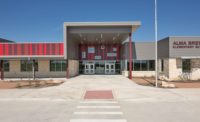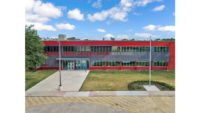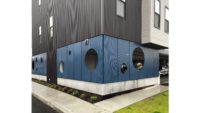The new Moving Everest Charter School, located in the Austin neighborhood on the Far West Side of Chicago, utilizes a unique model that accommodates both the new charter school as well as a provider of after-school programs. Grades K-5 constitute the school’s enrollment, with each grade totaling 90 students.
The new building’s vivid architecture signifies progress and innovation in the underserved neighborhood. More than 16,000 square feet of 7/8-inch PAC-CLAD corrugated panels finished in charcoal clad the exterior of the 53,000-square-foot structure. Approximately one-third of the corrugated panels are perforated and installed in front of supergraphic grayscale images of studious and smiling children that clearly show through perforated metal panels. The perforations are 3/8-in. on 9/16-inch centers.
The supergraphic images of children were printed on an aluminum composite material. A 4-in. cavity between the ACM and the PAC-CLAD perforated panels creates an eye-catching visual effect. The children pictured in the graphics are actual students in the after-school program.
Team A in Chicago created architectural design for the project. The design team employed the graphic techniques to signify the building’s dual uses, and to further establish the brand identity of the two participating nonprofit organizations. “When you’re working with non-profits, every penny counts. You try to get the most value from every component and material,” said Joe Buehler, Team A principal.
This was Buehler’s first use of Petersen corrugated material. “We considered two other manufacturers but settled on Petersen due to the local contractor’s comfort and experience with PAC-CLAD. The material is great—very cost-effective,” Buehler said.
WBR Roofing in Wauconda, Ill. completed installation of the corrugated panels. “We loaded the corrugated panels on the roof and lowered them down to be installed vertically,” said sheet metal superintendent Chuck Heintzelman. “Some of the panels were 40-ft. long and that was a bit of a challenge, but the job went smoothly once we got rolling on it.” WBR also installed the ACM image board behind the perforated panels.
The corrugated panels were fabricated at Petersen’s headquarters in Elk Grove Village, Ill. WBR Roofing fabricated all necessary trim, coping and brake metal on-site.
The use of corrugated architectural metal has become quite popular with designers during the past decade. “Corrugated material has historically been thought of as ‘barn material’ but there are plenty of projects over the past 15 to 20 years where architects have used it in a creative application, and were able to detail it in an innovative, modern way of taking an unrefined material and making it refined,” said architect Buehler. “The exposed fasteners are not a problem for me. I often think they sort of vanish within the concaves of the corrugation. It seems like where you strike the line of fasteners can present a very organized feel. The PAC-CLAD corrugated material served many purposes for this particular client.”
Students Loom Large Through Perforated Metal on School’s Façade










Report Abusive Comment